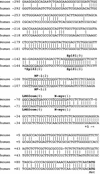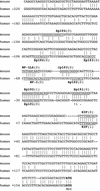Basal transcriptional regulation of human damage-specific DNA-binding protein genes DDB1 and DDB2 by Sp1, E2F, N-myc and NF1 elements
- PMID: 12527763
- PMCID: PMC140516
- DOI: 10.1093/nar/gkg152
Basal transcriptional regulation of human damage-specific DNA-binding protein genes DDB1 and DDB2 by Sp1, E2F, N-myc and NF1 elements
Abstract
The human DDB1 and DDB2 genes encode the 127 and 48 kDa subunits, respectively, of the damage-specific DNA-binding protein (DDB). Mutations in the DDB2 gene have been correlated with the hereditary disease xeroderma pigmentosum group E. We have investigated the proximal promoters of the DDB genes, both of which are G/C-rich and do not contain a TATA box. Transient expression analysis in HeLa cells using a luciferase reporter system indicated the presence of core promoters located within 292 bp (DDB1) and 220 bp (DDB2) upstream of the putative transcription initiation sites. Both core promoters contain multiple active Sp1 sites, with those of DDB1 at -123 to -115 and of DDB2 at -29 to -22 being critical determinants of promoter activity. In addition, an N-myc site at -56 to -51 for DDB1 is an essential transcription element, and mutations in a DDB1 NF-1 site at -104 to -92, a DDB2 NF-1 site at -68 to -56 and a DDB2 E2F site at +36 to +43 also reduce promoter activity. Taken together, these results suggest a regulation of basal transcription typical of cell cycle-regulated genes, and therefore support conjectures that the DDB heterodimer and/or its subunits have functions other than direct involvement in DNA repair.
Figures






References
-
- Cleaver J.E. and Kraemer,K.H. (1995) Xeroderma pigmentosum and Cockayne Syndrome. In Scriver,C.R., Beaudet,A.L., Sly,W.S. and Valle,D. (eds), The Metabolic and Molecular Bases of Inherited Disease, Vol. III. McGraw-Hill, New York, NY, pp. 4393–4419.
-
- Chu G. and Chag,E. (1988) Xeroderma pigmentosum group E cells lack a nuclear factor that binds to damaged DNA. Science, 242, 564–567. - PubMed
-
- Kataoka H. and Fujiwara,Y. (1991) UV-damage-specific DNA-binding protein in xeroderma pigmentosum complementation group E. Biochem. Biophys. Res. Commun., 175, 1139–1143. - PubMed
-
- Keeney S., Wein,H. and Linn,S. (1992) Biochemical heterogeneity in xeroderma pigmentosum complementation group E. Mutat. Res., 273, 49–56. - PubMed
Publication types
MeSH terms
Substances
Grants and funding
LinkOut - more resources
Full Text Sources
Research Materials
Miscellaneous

